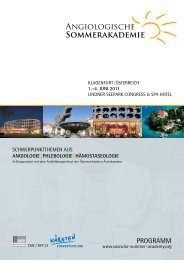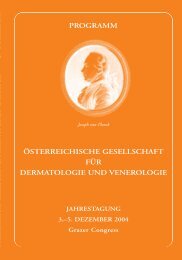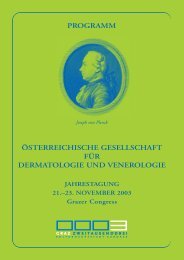PROGRAMM JAHRESTAGUNG 2012 30. Nov. – 2. Dez ... - ÖGDV
PROGRAMM JAHRESTAGUNG 2012 30. Nov. – 2. Dez ... - ÖGDV
PROGRAMM JAHRESTAGUNG 2012 30. Nov. – 2. Dez ... - ÖGDV
Erfolgreiche ePaper selbst erstellen
Machen Sie aus Ihren PDF Publikationen ein blätterbares Flipbook mit unserer einzigartigen Google optimierten e-Paper Software.
Freie Vorträge<br />
FV 6<br />
Combined targeting of MEK and PI3K/mTOR pathways effectively inhibits NRAS<br />
mutant melanoma in vitro and in vivo<br />
Christian Posch 1,2<br />
Homayoun Moslehi 1<br />
Luzviminda Feeney 1<br />
Anoosheh Abaee 1<br />
Lily Peng 1<br />
Gary Green 1<br />
Valentin Feichtenschlager 2<br />
Philip LeBoit 1<br />
Susana Ortiz 1<br />
1 University of California San Francisco Department of Dermatology Mt. Zion Cancer<br />
Research Center 2340 Sutter Street N461, San Francisco CA-94115, USA<br />
2 Krankenanstalt Rudolfstiftung Abteilung für Dermatologie und Venerologie,<br />
Juchgasse 25, 1030 Wien<br />
Introduction: Activating mutations in the NRAS gene are among the most common<br />
genetics events in malignant melanoma being found in 15-25% of melanomas. Mutated<br />
NRAS proteins activate signaling pathways that promote the cell division cycle and cell<br />
growth and suppress apoptosis. However, efforts at developing therapeutics that inhibit<br />
mutant RAS directly have so far not been very successful. We investigated the effects<br />
of blocking two major downstream signaling pathways of mutant NRAS, the<br />
RAS/RAF/ERK and the PI3K/AKT/mTOR pathway with currently available inhibitors.<br />
Material and Methods: Immunohistochemistry was used to analyze 14 primary<br />
melanomas and 18 melanoma metastases for phospho-protein levels in the<br />
RAS/RAF/ERK and the PI3K/AKT/mTOR cascade. We further evaluated the influence of<br />
different components of the MEK and PI3K/mTOR cascade in a large set of NRAS mutant<br />
melanoma cell lines employing a pool of single and combined inhibitors. Statistical and<br />
mathematical models were used to calculate synergistic effects of inhibitor<br />
combinations. Cell viability and apoptosis assays as well as kinome array analysis were<br />
performed. Results were translated into a xenograft mouse model of NRAS mutant<br />
melanoma.<br />
Results: We found that combined targeting of MEK, PI3K and mTOR pathways is<br />
necessary to effectively inhibit NRAS mutant melanoma cells. We learned that mTORC2<br />
inhibition is more powerful in reducing cell growth than inhibition of mTORC1.<br />
Comparing the inhibitory effects of selective mTOR and PI3K inhibitors we observed,<br />
that dual inhibitors of PI3K and mTOR were generally more powerful in reducing cell<br />
growth than selective mTOR and PI3K inhibitors alone or in combination. The<br />
combination of MEK/PI3K was superior to MEK/mTOR in all NRAS mutant melanoma<br />
28









